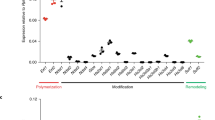Abstract
Heparan sulfate (HS) is a linear polysaccharide with complex structures and modulates a wide range of biological functions. Elucidating the structure–function relationship of HS has been challenging. Recently, we generated a HS mutant mouse lung endothelial cell library by systematic deletion of HS genes expressed in the cell individually or in their combination. Here, we describe the experimental procedure using the mutant cell library to determine the structure–function relationship of HS in the regulation of FGF2-FGFR1 signaling at the levels of cell surface FGF2 binding and the downstream intracellular signaling activation. Our results demonstrated that strictly defined fine structure is required for HS to act as a co-receptor for FGF2-FGFR1 signaling.
Access this chapter
Tax calculation will be finalised at checkout
Purchases are for personal use only
Similar content being viewed by others
References
Bishop JR, Schuksz M, Esko JD (2007) Heparan sulphate proteoglycans fine-tune mammalian physiology. Nature 446(7139):1030–1037
Esko JD, Selleck SB (2002) Order out of chaos: assembly of ligand binding sites in heparan sulfate. Annu Rev Biochem 71:435–471
Kjellen L (2003) Glucosaminyl N-deacetylase/N-sulphotransferases in heparan sulphate biosynthesis and biology. Biochem Soc Trans 31(2):340–342
Esko JD, Lindahl U (2001) Molecular diversity of heparan sulfate. J Clin Invest 108(2):169–173
Zhao J, Zhu Y, Song X et al (2019) 3-O-sulfation of heparan sulfate enhances tau interaction and cellular uptake. Angew Chem Int Ed 59:1818–1827
Stringer SE (2006) The role of heparan sulphate proteoglycans in angiogenesis. Biochem Soc Trans 34(Pt 3):451–453
Presta M, Dell'Era P, Mitola S et al (2005) Fibroblast growth factor/fibroblast growth factor receptor system in angiogenesis. Cytokine Growth Factor Rev 16(2):159–178
Iozzo RV, San Antonio JD (2001) Heparan sulfate proteoglycans: heavy hitters in the angiogenesis arena. J Clin Invest 108(3):349–355
Rai S, Alsaidan OA, Yang H et al (2020) Heparan sulfate inhibits transforming growth factor beta signaling and functions in cis and in trans to regulate prostate stem/progenitor cell activities. Glycobiology 30(6):381–395. https://doi.org/10.1093/glycob/cwz103
Bernfield M, Gotte M, Park PW et al (1999) Functions of cell surface heparan sulfate proteoglycans. Annu Rev Biochem 68:729–777
Wang L, Brown JR, Varki A, Esko JD (2002) Heparin's anti-inflammatory effects require glucosamine 6-O-sulfation and are mediated by blockade of L- and P-selectins. J Clin Invest 110(1):127–136
Xu D, Esko JD (2014) Demystifying heparan sulfate-protein interactions. Annu Rev Biochem 83:129–157
Bai X, Wei G, Sinha A, Esko JD (1999) Chinese hamster ovary cell mutants defective in glycosaminoglycan assembly and glucuronosyltransferase I. J Biol Chem 274(19):13017–13024
Esko JD, Rostand KS, Weinke JL (1988) Tumor formation dependent on proteoglycan biosynthesis. Science 241(4869):1092–1096
Esko JD, Stewart TE, Taylor WH (1985) Animal cell mutants defective in glycosaminoglycan biosynthesis. Proc Natl Acad Sci U S A 82(10):3197–3201
Wijelath E, Namekata M, Murray J et al (2010) Multiple mechanisms for exogenous heparin modulation of vascular endothelial growth factor activity. J Cell Biochem 111(2):461–468
Zhang B, Xiao W, Qiu H et al (2014) Heparan sulfate deficiency disrupts developmental angiogenesis and causes congenital diaphragmatic hernia. J Clin Invest 124(1):209–221
Qiu H, Xiao W, Yue J, Wang L (2015) Heparan sulfate modulates Slit3-induced endothelial cell migration. Methods Mol Biol 1229:549–555
Zhang B, Dietrich UM, Geng JG et al (2009) Repulsive axon guidance molecule Slit3 is a novel angiogenic factor. Blood 114(19):4300–4309
Qiu H, Shi S, Yue J et al (2018) A mutant-cell library for systematic analysis of heparan sulfate structure-function relationships. Nat Methods 15(11):889–899
Qiu H, Jiang JL, Liu M et al (2013) Quantitative phosphoproteomics analysis reveals broad regulatory role of heparan sulfate on endothelial signaling. Mol Cell Proteomics 12(8):2160–2173
Schlessinger J, Plotnikov AN, Ibrahimi OA et al (2000) Crystal structure of a ternary FGF-FGFR-heparin complex reveals a dual role for heparin in FGFR binding and dimerization. Mol Cell 6(3):743–750
Jastrebova N, Vanwildemeersch M, Rapraeger AC et al (2006) Heparan sulfate-related oligosaccharides in ternary complex formation with fibroblast growth factors 1 and 2 and their receptors. J Biol Chem 281(37):26884–26892
Kreuger J, Jemth P, Sanders-Lindberg E et al (2005) Fibroblast growth factors share binding sites in heparan sulphate. Biochem J 389:145–150
Xie M, Li JP (2019) Heparan sulfate proteoglycan – a common receptor for diverse cytokines. Cell Signal 54:115–121
Nakato H, Kimata K (2002) Heparan sulfate fine structure and specificity of proteoglycan functions. Biochim Biophys Acta 1573(3):312–318
Habuchi H, Habuchi O, Kimata K (2004) Sulfation pattern in glycosaminoglycan: does it have a code? Glycoconj J 21(1–2):47–52
Turnbull JE, Fernig DG, Ke Y et al (1992) Identification of the basic fibroblast growth factor binding sequence in fibroblast heparan sulfate. J Biol Chem 267(15):10337–10341
Maccarana M, Casu B, Lindahl U (1993) Minimal sequence in heparin/heparan sulfate required for binding of basic fibroblast growth factor. J Biol Chem 268(32):23898–23905
Ashikari-Hada S, Habuchi H, Kariya Y et al (2004) Characterization of growth factor-binding structures in heparin/heparan sulfate using an octasaccharide library. J Biol Chem 279(13):12346–12354
Guimond SE, Turnbull JE (1999) Fibroblast growth factor receptor signalling is dictated by specific heparan sulphate saccharides. Curr Biol 9(22):1343–1346
Kamimura K, Koyama T, Habuchi H et al (2006) Specific and flexible roles of heparan sulfate modifications in Drosophila FGF signaling. J Cell Biol 174(6):773–778
Acknowledgments
The research was supported by NIH R21HL131553, P41GM103390, 5R01HL093339, U01CA225784, and R56 AG062344.
Author information
Authors and Affiliations
Corresponding author
Editor information
Editors and Affiliations
Rights and permissions
Copyright information
© 2022 Springer Science+Business Media, LLC, part of Springer Nature
About this protocol
Cite this protocol
Faulkner, J., Song, X., Wang, L. (2022). Application of a Mutant Cell Library to Determine the Structure–Function Relationship of Heparan Sulfate in Facilitating FGF2-FGFR1 Signaling. In: Balagurunathan, K., Nakato, H., Desai, U., Saijoh, Y. (eds) Glycosaminoglycans. Methods in Molecular Biology, vol 2303. Humana, New York, NY. https://doi.org/10.1007/978-1-0716-1398-6_48
Download citation
DOI: https://doi.org/10.1007/978-1-0716-1398-6_48
Published:
Publisher Name: Humana, New York, NY
Print ISBN: 978-1-0716-1397-9
Online ISBN: 978-1-0716-1398-6
eBook Packages: Springer Protocols




